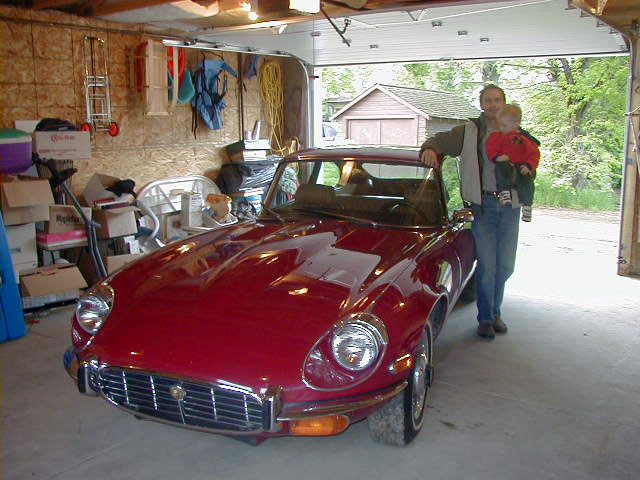My brother just took delivery of a 1973 2+2 V12 e-type.
He's not mechanically inclined...I am somewhat.
I checked his carbs and they all had very little trace of oil in the dashpot. I am familiar with SU carbs, but not Stromberg's. (I'm assumming it's the same theory).....I filled then to just below the theads with ATF. The car seems to bog down when the initially accelerating.
Should I be using a thicker/thinner oil? Have I used too much oil..?
Secondly.....Ive never heard..let alone driven a V12. The sound at idle was a sound I didn't expect. It sounds like a 6 cyl. Could one side of the exhaust be plugged...? (I didn't think to put my ear down to the pipes).
Thanks for any replies...excuse my nievety..
Cheers

Submitted by mtoon@sasktel.net on Mon, 06/07/2004 - 21:59
Submitted by NE52-32043 on Mon, 06/07/2004 - 15:10
Re.: Carbs
Matthew,
You don't want to run lean. You probably want to be slightly to the rich side (but not too rich). Lean could produce some of the symptoms you described and lack of power. Also, lean running will lead to overheating, so adjust the carbs a little richer. You need a special tool to adjust the carbs, but it is inexpensive and worth the price. Follow the adjusting procedure in the manual. And consider changing the plugs -- you'll be surprised how much it effects running.
As for the rear brakes, you can access them from inside the car. The rear seat comes out and there are two access plates that allow you to see the rear brakes. You can see if they are hanging up or retracting, and the condition of the pads. You might try pulling the brake pads out and shooting some brake cleaner in and see if that will free them up. You can also bleed the brakes from there as well.
Steve Weinstein, JTC-NJ
'72 E-type 2+2
'70 XKE FHC
Submitted by mtoon@sasktel.net on Sun, 06/06/2004 - 23:05
Re.: Carbs
Steve,
Thanks very much for you information....much appreciated.
I was with the Jag this weekend but did not get enough time with it.
All I had time for was to take it for a run....I pulled the plugs after ht erun to see what was happening.
I did not know the gap required before now...but I believe they looked a little tighter than .025.
All of the plugs looked pretty good...borderline lean....except those fed by the right rear carb. They looked very black, so running rich there.
I also checked the diaphrams in the two easiest to remove dashpots....their fine.
Also...after a few stop and goes..the rear brakes begin to stick for about 100yds after releasing.....?
Submitted by NE52-32043 on Thu, 06/03/2004 - 18:02
Re.: Carbs
A couple of other thoughts if the other stuff doesn't work. Did your brother have a compression test done before he bought the car? If not, when you pull the plugs you might want to do that.
It is also possible that one or more of the magnetic rods in the distributor may have fallen out of the trigger wheel. That's easy enough to see if you pull the distribtor cap. If so, get a good quality replacement.
Once you get the car running, dump the coolant and flush the radiator and block out really well. Change the thermostats (I use 82 deg. stats). Make sure that they have the jiggle valve and that it's installed at 12 o'clock position. Refill with 50/50 mix of steam distilled water and anti-freeze, with a bottle of Red Line Water Wetter added. These engines are notorious for overheating (ask me how I know), so you want to be sure the cooling system is in top shape.
Steve Weinstein, JTC-NJ
'72 E-type 2+2
'70 XKE FHC
Submitted by NE52-32043 on Thu, 06/03/2004 - 17:51
Re.: Carbs
I must respectfully disagree with William on this point. I use ATF in my Ser. III 2+2 and it's fine. In fact, I prefer it to engine oil. I just had the car up at Lime Rock, running on the track, and the carbs responded perfectly. I also use it in the SU's on my '70 FHC. Joe Curto, the carb guru who rebuilt both the SU's and the ZS's on my cars said use ATF. But engine oil is good too. Unless you're using 90W oil, it won't make a noticable difference. When filling, fill to within 1/4" of the top of the inner tube (NOT the outer tube). If you overfill, the excess will run down into the carbs and end up in the engine, which won't hurt anything but may cause some smoking. It won't cause the symptoms you're describing.
As far as performance goes, it is very unlikely that the exhaust is plugged. If it was, you'd have trouble turning the engine over, or it would have blown by now. Put your hand in front of the exhaust pipe in the rear and you'll tell pretty quickly if one side or the other is not running right.
You need to check all the basics, and possibly replace some things -- check all the wires to be sure they're in good condition (better yet, get a replacement set -- I like the Magnecor 8mm wires). Pull the spark plugs one at a time (make sure the holes are clean before pulling by blowing them out with compressed air). Plugs should be clean and gapped to .025". Consider replacing the plugs. I like the NGK's. Important -- gap to .025". Check the distributor cap and rotor, better yet, replace them (buy the good stuff, not the cheap after-market stuff). Last, check ALL of the vacuum lines and connections. A vacuum leak can play havic with performance on these cars. Buy fresh vacuum hose and clamp all the larger connections. Change the air filters too, if they haven't been changed in a while.
Also, when checking the timing, make sure the mechanical advance is working by disconnecting the vacuum retard line from the distributor (plug the hose so no vacuum leak), set timing at 12 deg. BTDC at idle, and then rev the engine with the timing light on. If the timing does not advance significantly, the mechanical advance could be frozen (a fairly common problem on these old distributors).
This may sound like a lot, but it is all easy stuff that takes little skill. Get the official Jaguar repair manual and part manual. You can often find them on Ebay or on Amazon or similar booksellers.
The engine on the V-12 E-types should be smooth and relatively quiet. Idle should be smooth, not lumpy. If it sounds like a 6, something is wrong. The car should idle smoothly and accelerate nicely, with decent power, no hesitation.
Steve Weinstein, JTC-NJ
'72 E-type 2+2
'70 XKE FHC
Submitted by mtoon@sasktel.net on Sun, 05/30/2004 - 14:31
Re.: Carbs
Thanks for the reply.....
Would the ATF be too thin, thus causing the bogging out on acceleration?
Is 10/30 thick enough?.......that just made me think of another question...what is the recommended engine oil when we change it?
(we did not receive the manual, and have not found a Haynes yet)
Thanks
Submitted by bonnettoboot@e… on Sun, 05/30/2004 - 13:29
Re.: Carbs
You must use engine oil and only enough to feel the resistance when you push in the damper piston, only about 1/2 an inch is needed. Many people use ATF and it stems from the use of vehicles operated in very cold climates, (particularly volvo). At temeratures well below freezing engine oil was too thick. Simply remove the plug wires one at a time to see which cylinders are firing.
Jaguar affectionado and etc.


Very helpful...thank you!
I'll get at that on the weekend...fortunately kids have a soccer tournament in my brothers city.
So the carbs aren't like adjusting an HS type SU...? On those, they are adjusted by turning the mixture nut (raising/lowering the jet) under the carb.
Which plugs should one use on the V12? Sorry if someone answered that already....can't see the old posts. I can't recall the number of what is in there at the moment but I believe started with a "B"
btw....Lean running can cause overheating? How is this?